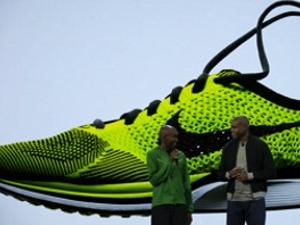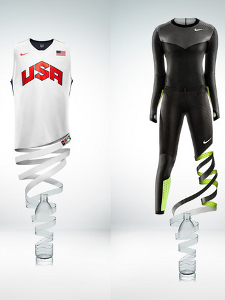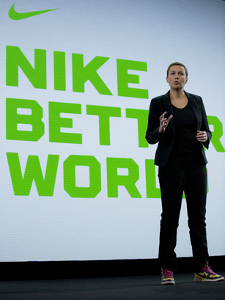 |
| Reviews and Templates for Expression We |
Will Greener Shoes and Uniforms Bring Nike More Olympics Gold?

Nike hopes to win both green and gold at this summer's Olympics in London.
On Tuesday in New York City, the sporting-goods giant unveiled a new line of sportswear designed to help Olympians go faster, farther and longer. Nike is manufacturing its 2012 Olympic kits using less material -- and more recycled plastics -- than in the past.
The announcement came as part of a series of "cutting-edge, lightweight performance innovations designed for the track, the basketball court and beyond for this summer," CEO Mark Parker said.
To me, the most visibly different ecoinnovation is Nike's Flyknit shoe design.
Instead of the conventional assembly of fabrics, rubber, leather and other materials, the Flyknit comprises a single piece of a flexible mesh knit, a strong yet pliant fabric that fits like a sock over a wearer's foot.
Eliminating so much material cuts each shoe's weight by approximately 20 percent to about 160 grams. That may not sound like much, but multiplied by the 40,000 steps it takes to run a marathon, that totals about the weight of a car -- a ton or so -- that elite marathoners will no longer need to lift, said Martin Lotti, Nike's global creative director for the Olympics.
Less material also means lower environmental impact. It's an example "that sustainability can improve performance," Hannah Jones, Nike's vice president of sustainable innovation, told me.
Nike is rolling out two versions of the Flyknit: a racing flat and a training shoe. Athletes from Great Britain, Kenya, Russia and the U.S. plan to wear the Flyknit at the games. At the event this week, 10-time gold-medal winner Carl Lewis spoke with 2012 Olympic team member Abdi Abdirahman (both pictured at right) about the Flyknit shoes.
A similar idea helped shape the company's new line of Olympic uniforms. Here, Nike has boosted its use of recycled polyester to produce lighter fabrics for a variety of shorts and tops – and even a wearable racing skin called Nike Pro TurboSpeed. It's basically a speed suit that's covered in dimples, which act like the surface of a golf ball, reducing drag by creating a thin layer of turbulence as an athlete cuts through the air.
By making the fabrics from discarded plastic bottles, the recycled polyester fabrics cut energy consumption by roughly a third compared with virgin materials.
Next page: How recycled plastic helps athletes as much as the environment
The national basketball teams from Brazil, China and the U.S. will wear Nike Hyper Elite uniforms made from plastic reclaimed from 22 recycled bottles (pictured below). The shorts are ethereally light, weighing just about 5 ounces, a quarter of the weight of uniforms worn by today's NBA pros.
Lighter uniforms translate into less fatigue, more comfort and better performance, said Deron Williams of the New Jersey Nets, who endorses Nike and is expected to play for Team USA in the 2012 games.
Soccer players tend to be a bit smaller than basketball players, so just 13 bottles are necessary to make each of their kits. Still, it adds up: Nike's reuse of plastic bottles has diverted more than 82 million of the containers from landfills.
Speaking with me after the announcement, Lorrie Vogel, Nike's general manager of Considered Design, told me how competitive Nike's designers are.
 "It's a company full of ex-athletes, where we're constantly scored on our performance, and green-design benchmarking is no exception," she said.
"It's a company full of ex-athletes, where we're constantly scored on our performance, and green-design benchmarking is no exception," she said.
I wondered if that competition makes Nike protective of its proprietary-materials innovations. The recipe for an ultra-lightweight shoe that may be worn on the Olympic podium this summer is worth protecting.
The company shares sustainability know-how strategically, Jones told me. New product or new material design recipes are typically strictly confidential, but design tools and shared materials knowledge is just the opposite, she said.
Jones, pictured at right, believes that among the many industries pushing the sustainability frontier, sports gear makers are among the most collaborative. For example, Nike and its competitors, Adidas and Puma, "recognize the benefit of sharing the recipe for green rubber with our suppliers," she explained. "We know that if our competitors start ordering it too, the price will fall, supplies will improve, and that will lead to the faster change on a larger scale."
Consistent with that collaborative approach to competition, Jones reminded me that today's announcement follows a burst of intraindustry green-design initiatives that Nike has announced in the past 18 months. These include:
initiatives that Nike has announced in the past 18 months. These include:
- Waterless dyeing. Earlier this month, Nike announced it was rolling out a water-free dyeing method. Though limited in application for now, the approach has the potential to radically reduce the enormous volumes of water the industry consume using conventional methods to color textiles.
- Zero toxins. The waterless dyeing fits into a broader push to cut toxic emissions to nil. Last fall, as part of a coalition that also includes Adidas, C&A, H&M, Li Ning, and Puma, Nike released a roadmap toward a goal of achieving "zero discharge of hazardous chemicals for all products, across all pathways in our supply chain, by 2020." The initiative ties together separate efforts in water reduction, organic cotton, green chemistry and materials traceability and sustainability.
- Design tool sharing. Throughout 2011, Nike launched a series of proprietary tools to help designers speed up their selection of sustainable materials. Nike released its Environmental Apparel Design Tool, a data set and calculator incorporating more than a decade's worth of knowledge about material attributes. The company uses a similar tool for its Considered Design methodology to assess the impact of its products.
|
|
|
|
Copyright 2011 Energy and Technical Services Ltd. All Rights Reserved. Energyts.com |